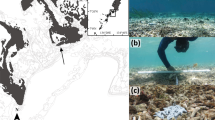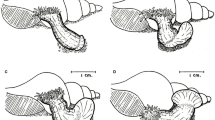Abstract
Parasitic castration is an adaptive strategy where the parasite usurps its host’s phenotype, most notably the host’s reproductive effort. Though castrators are loosely known to be large relative to their hosts (compared to typical parasites), their mass has rarely been quantified and little is known about size variation, even if such variation exists. By cross-sectioning snails, we examined intra- and inter-specific variation in the parasite/host mass of 15 trematode species that castrate the California horn snail, Cerithidea californica. Trematode species occupied 14–39% (mean = 20.3%) of an infected snail’s soft tissue mass. Intraspecific variation in castrator mass fluctuated with variables that covary with energy available for host reproduction. Specifically, trematode mass was 24% higher in summer than in winter, 15% greater in snails from intertidal flats than from tidal channels, and increased with host mass to the 1.37 power (a finding contrary to that previously documented for other types of parasites). Relative body mass differed across trematode species, varying interspecifically with: (1) taxonomic family, (2) host tissue use (larger species used more types of host-tissue), (3) position in the trematode interspecific competitive dominance hierarchy (the two most subordinate species were the largest, otherwise size tended to increase with dominance), and (4) type of host used by offspring (species whose offspring infect relatively predictably occurring benthic invertebrates were larger than those infecting transient vertebrates). Our findings suggest that ecological constraints and life history trade-offs between reproduction and survival influence the mass of these very large parasites.




Similar content being viewed by others
References
Aristotle (350 BCE) (2004) Historia animalium (translated by D.W. Thompson, 1910). eBooks@Adelaide, The University of Adelaide Library
Armitage AR, Fong P (2004) Upward cascading effects of nutrients: shifts in a benthic microalgal community and a negative herbivore response. Oecologia 139:560–567
Baudoin M (1975) Host castration as a parasitic strategy. Evolution 29:335–352
Benjamini Y, Hochberg Y (1995) Controlling the false discovery rate: a practical and powerful approach to multiple testing. J Roy Stat Soc Ser B-Methodol 57:289–300
Bull JJ (1994) Virulence. Evolution 48:1423–1437
Combes C (2001) Parasitism: the ecology and evolution of intimate interactions; translated by Isaure de Buron and Vincent A. Connors; with a new foreword by Daniel Simberloff. University of Chicago Press, Chicago
DeCoursey PJ, Vernberg WB (1974) Double infections of larval trematodes: competitive interactions. In: Vernberg WB (ed) Symbiosis in the sea. University of South Carolina Press, Columbia, pp 93–109
Edgington ES (1995) Randomization tests, 3rd edn. Marcel Dekker, Inc., New York
Esch GW, Curtis LA, Barger MA (2001) A perspective on the ecology of trematode communities in snails. Parasitology 123:S57–S75
Felsenstein J (1985) Phylogenies and the comparative method. Am Nat 125:1–15
Frank SA (1996) Models of parasite virulence. Q Rev Biol 71:37–78
Gaines SD, Rice WR (1990) Analysis of biological data when there are ordered expectations. Am Nat 135:310–317
George-Nascimento M, Munoz G, Marquet PA, Poulin R (2004) Testing the energetic equivalence rule with helminth endoparasites of vertebrates. Ecol Lett 7:527–531
Haldeman SS (1840) A monograph of the Limniades and other freshwater univalve shells of North America. J. Dobson, Philadelphia
Hall SR, Becker C, Caceres CE (2007) Parasitic castration: a perspective from a model of dynamic energy budgets. Integr Comp Biol 47:295–309
Hansen TF (1997) Stabilizing selection and the comparative analysis of adaptation. Evolution 51:1341–1351
Harvey PH, Pagel MD (1991) The comparative method in evolutionary biology. Oxford University Press, Oxford
Hechinger RF, Lafferty KD, Kuris AM Diversity increases biomass production for trematode parasites in snails. (submitted)
Hurst CT (1927) Structural and functional changes produced in the gastropod mollusk, Physa occidentalis, in the case of parasitism by the larvae of Echinostoma revolutum. Univ Calif Publ Zool 29:321–404
Huspeni TC (2000) A molecular genetic analysis of host specificity, continental geography, and recruitment dynamics of a larval trematode in a salt marsh snail. Dissertation, University of California, Santa Barbara
Huspeni TC, Hechinger RF, Lafferty KD (2005) Trematode parasites as estuarine indicators: opportunities, applications and comparisons with conventional community approaches. In: Bortone S (ed) Estuarine indicators. CRC Press, Boca Raton, pp 297–314
Jackson DA, Somers KM (1991) The spectre of ‘spurious’ correlations. Oecologia 86:147–151
Keeney DB, Waters JM, Poulin R (2007) Clonal diversity of the marine trematode Maritrema novaezealandensis within intermediate hosts: the molecular ecology of parasite life cycles. Mol Ecol 16:431–439
Kenney BC (1982) Beware of spurious self-correlations! Water Resour Res 18:1041–1048
Kozlowski J (1992) Optimal allocation of resources to growth and reproduction: implications for age and size at maturity. Trends Ecol Evol 7:15–19
Kuris AM (1974) Trophic interactions––similarity of parasitic castrators to parasitoids. Q Rev Biol 49:129–148
Kuris AM (1990) Guild structure of larval trematodes in molluscan hosts: prevalence, dominance and significance of competition. In: Esch GW, Bush AO, Aho JM (eds) Parasite communities: patterns and processes. Chapman and Hall, London, pp 69–100
Kuris AM, Lafferty KD (1994) Community structure: larval trematodes in snail hosts. Annu Rev Ecol Syst 25:189–217
Kuris AM, Lafferty KD (2000) Parasite–host modeling meets reality: adaptive peaks and their ecological attributes. In: Poulin R, Morand S, Skorping A (eds) Evolutionary biology of host-parasite relationships: theory meets reality, vol 32. Elsevier, Amsterdam, pp 9–26
Lafferty KD (1993) Effects of parasitic castration on growth, reproduction and population dynamics of the marine snail Cerithidea californica. Mar Ecol Prog Ser 96:229–237
Lafferty KD, Sammond DT, Kuris AM (1994) Analysis of larval trematode communities. Ecology 75:2275–2285
Lafferty KD, Hechinger RF, Shaw JC, Whitney KL, Kuris AM (2006) Food webs and parasites in a salt marsh ecosystem. In: Collinge SK, Ray C (eds) Disease ecology: community structure and pathogen dynamics. Oxford University Press, Oxford, pp 119–134
Lagrue C, McEwan J, Poulin R, Keeney DB (2007) Co-occurrences of parasite clones and altered host phenotype in a snail-trematode system. Int J Parasitol 37:1459–1467
Martin WE (1972) An annotated key to the cercariae that develop in the snail Cerithidea californica. Bull South Calif Acad Sci 71:39–43
McCarthy HO, Fitzpatrick S, Irwin SWB (2002) Life history and life cycles: Production and behavior of trematode cercariae in relation to host exploitation and next-host characteristics. J Parasitol 88:910–918
McCloy MJ (1979) Population regulation in the deposit feeding mesogastropod Cerithidea californica as it occurs in a San Diego salt marsh habitat. Dissertation, University of California, San Diego
Minchella DJ, Sollenberger KM, de Souza CP (1995) Distribution of schistosome genetic diversity within molluscan intermediate hosts. Parasitology 111:217–220
Muñoz G, George-Nascimento M (1999) Reciprocal reproductive effects in the symbiosis between ghost shrimps (Decapoda: Thalassinidea) and bopyrid isopods (Isopoda: Epicaridea) at Lenga. Chile Rev Chil Hist Nat 72:49–56
Neter J, Kutner MH, Wasserman W, Nachtscheim C (1996) Applied linear regression models, 3rd edn. Irwin, Chicago
Olson PD, Cribb TH, Tkach VV, Bray RA, Littlewood DTJ (2003) Phylogeny and classification of the Digenea (Platyhelminthes: Trematoda). Int J Parasitol 33:733–755
Pianka ER, Parker WS (1975) Age-specific reproductive tactics. Am Nat 109:453–464
Poulin R (1998) Evolutionary ecology of parasites: from individuals to communities, 1st edn. Chapman & Hall, London
Poulin R, George-Nascimento M (2007) The scaling of total parasite biomass with host body mass. Int J Parasitol 37:359–364
Poulin R, Mouritsen KN (2003) Large-scale determinants of trematode infections in intertidal gastropods. Mar Ecol Prog Ser 254:187–198
Quinn GP, Keough MJ (2002) Experimental design and data analysis for biologists. Cambridge University Press, Cambridge
Race MS (1981) Field ecology and natural history of Cerithidea californica (Gastropoda: Prosobranchia) in San Francisco Bay. Veliger 24:18–27
Rauch G, Kalbe M, Reusch TBH (2005) How a complex life cycle can improve a parasite’s sex life. J Evol Biol 18:1069–1075
Read AF (1994) The evolution of virulence. Trends Microbiol 2:73–76
Reinhard EG (1956) Parasitic castration of Crustacea. Parasitology 5:79–107
Rice WR, Gaines SD (1994) The ordered-heterogeneity family of tests. Biometrics 50:746–752
Rothschild M (1936) Gigantism and variation in Peringia ulvae Pennant 1777, caused by infection with larval trematodes. J Mar Biol Assoc UK 20:537–546
Rothschild M, Clay T (1952) Fleas, flukes & cuckoos; a study of bird parasites. Philosophical Library, New York
Sall J (1990) Leverage plots for general linear hypotheses. Am Stat 44:308–315
Sorensen RE, Minchella DJ (2001) Snail-trematode life history interactions: past trends and future directions. Parasitology 123:S3–S18
Sousa WP (1983) Host life history and the effect of parasitic castration on growth a field study of Cerithidea californica (Gastropoda: Prosobranchia) and its trematode parasites. J Exp Mar Biol Ecol 73:273–296
Sousa WP (1990) Spatial scale and the processes structuring a guild of larval trematode parasites. In: Esch GW, Bush AO, Aho JM (eds) Parasite communities: patterns and processes. Chapman & Hall, New York, pp 41–67
Sousa WP (1993) Interspecific antagonism and species coexistence in a diverse guild of larval trematode parasites. Ecol Monogr 63:103–128
Sousa WP, Gleason M (1989) Does parasitic infection compromise host survival under extreme environmental conditions: the case for Cerithidea californica (Gastropoda: Prosobranchia). Oecologia, Berlin 80:456–464
Stearns SC (1992) The evolution of life histories. Oxford University Press, Oxford; New York
Taskinen J, Makela T, Valtonen ET (1997) Exploitation of Anodonta piscinalis (Bivalvia) by trematodes: parasite tactics and host longevity. Ann Zool Fenn 34:37–46
Williams GC (1966) Adaptation and natural selection: a critique of some current evolutionary thought. Princeton University Press, Princeton
Wilson RA, Denison J (1980) Parasitic castration and gigantism of Lymnaea truncatula infected with the larval stages of Fasciola hepatica. Z Parasitenkd 61:109–119
Yamaguti S (1971) Synopsis of digenetic trematodes of vertebrates. Keigaku Publishing Co., Tokyo
Yoshino TP (1975) A seasonal and histologic study of larval Digenea infecting Cerithidea californica (Gastropoda: Prosobranchia) from Goleta Slough, Santa Barbara County, California, USA. Veliger 18:156–161
Yoshino TP (1976a) Histopathological effects of larval Digenea on digestive epithelia of marine prosbranch Cerithidea californica: fine-structural changes in the intestine. J Invertebr Pathol 28:309–313
Yoshino TP (1976b) Histopathological effects of larval Digenea on digestive epithelia of marine prosobranch Cerithidea californica: fine-structural changes in digestive gland. J Invertebr Pathol 28:209–216
Zimmer C (2000) Parasite rex: inside the bizarre world of nature’s most dangerous creatures. Free Press, New York
Acknowledgements
We thank the University of California NRS for allowing access to field sites. We are also grateful to L. Mababa, E. Abe, and V. Frankel for assisting with field and/or lab work; and several anonymous reviewers and V. Jormalainen for helpful comments. We thank J. Lorda for information on diatom densities. Financial support came from a US NIH/NSF EID Program grant to AMK and KDL (DEB-0224565). Any use of trade, product, or firm names in this publication is for descriptive purposes only and does not imply endorsement by the U.S. government.
Author information
Authors and Affiliations
Corresponding author
Electronic supplementary material
Below is the link to the electronic supplementary material.
Rights and permissions
About this article
Cite this article
Hechinger, R.F., Lafferty, K.D., Mancini, F.T. et al. How large is the hand in the puppet? Ecological and evolutionary factors affecting body mass of 15 trematode parasitic castrators in their snail host. Evol Ecol 23, 651–667 (2009). https://doi.org/10.1007/s10682-008-9262-4
Received:
Accepted:
Published:
Issue Date:
DOI: https://doi.org/10.1007/s10682-008-9262-4




